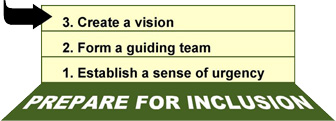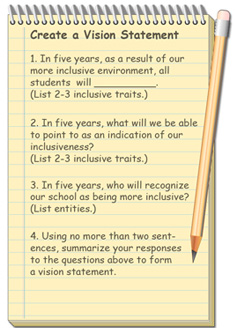How can school leaders prepare for the changes required to create inclusive school environments?
Page 7: Create a Vision
 Once a guiding team has been formed, the next step is to create a shared vision among its members. The guiding team’s vision is a description of their desired future school and how that school will be different from the current one. The vision leads the actions of the guiding team through the change process.
Once a guiding team has been formed, the next step is to create a shared vision among its members. The guiding team’s vision is a description of their desired future school and how that school will be different from the current one. The vision leads the actions of the guiding team through the change process.
Identify What Works
Before creating their school’s vision, the team must first understand common characteristics indicative of an inclusive school environment. To do so, they should gather information about inclusion by reviewing current research literature, contacting professional development organizations, communicating with other school personnel practicing inclusion, and reaching out to local university faculty, among other methods. Ideally, the guiding team should visit at least one inclusive school—and more if possible—that matches their own school in terms of size and demographics. Conducting a school visit allows the team members to observe an inclusive school environment as well as to view the inclusive practices being implemented at the classroom level. In addition, it allows them to meet with administrators and teachers to discuss any questions they may have about creating an inclusive school.
Inclusive School Characteristics
The inclusive school characteristics listed below were derived from Lipsky and Gartner’s Quality Indicators of an Inclusive Environment (2008)––a tool that will be introduced later in this module.
| Inclusive School Characteristics | |
School Climate |
|
Curriculum, instruction, and assessment |
|
Staff development |
|
Support services |
|
Parent involvement |
|
Community involvement |
|
Resources |
|
School self-evaluation |
|
Comprehensive education plan |
|
Note: These are commonly agreed-upon characteristics of inclusive schools. For other articles that discuss traits or characteristics of inclusive schools see:
Causton-Theoharis, J., & Theoharis, G. (2008). Creating inclusive schools for all students. School Administrator, 65(8), 24–30.
Ferguson, D. L., Kozleski, E. B., & Smith, A. S. (2005, November). On…transformed, inclusive schools: A framework to guide fundamental change in urban schools. Retrieved on June 23, 2010, from http://www.askresource.org/Publications/Transformed%20Inclusive%20Schools.pdf
Swedeen, B. L. (2009, January). Signs of an inclusive school: A parent’s perspective on the meaning and value of authentic inclusion. TEACHING Exceptional Children Plus, 5(3). Retrieved on June 23, 2010, from http://escholarship.bc.edu/cgi/viewcontent.cgi?article=1621&context=education/tecplus
Waldron, N. L. (2000). Inclusive schools in action: making differences ordinary. Alexandria, VA: ASCD.
(Close this panel)
Create a Vision Statement
Next, the guiding team uses this information to establish a shared vision of an inclusive environment for their school. In doing so, the team may develop a completely new vision for their school or refine the existing vision statement. A good vision statement is:
- Clear and focused
- Challenging
- Specific, achievable, and realistic
- Inspiring
- Measurable
- Subject to refinement
By articulating their vision, the team can more effectively direct the change effort and increase the chances of achieving that vision. To the right is a set of guiding questions that the team can use to develop a vision. Below is a sample vision statement.
Notepad Description
This is a graphic of a yellow spiral notebook with a pencil lying beside it. At the top of the notebook page the paper is titled “Create a Vision Statement.” There are four steps numbered and written below this title. Step 1 states: In five years, as a result of our more inclusive environment, all students will _______ (List 2–3 inclusive traits.). After a skipped line, Step 2 states: In five years, what will we be able to point to as an indication of our inclusiveness? (List 2–3 inclusive traits.). After another skipped line, Step 3 states “In five years, who will recognize our school as being more inclusive? (List entities).” The last step, Step 4, after a skipped line, states “Using no more than two sentences, summarize your responses to the questions above to form a vision statement.”
Longview Middle School Vision Statement
Longview Middle School will serve all students in integrated, heterogeneous classrooms, regardless of ability/ disability, language, or educational need, through a collaborative culture in which adults share responsibility and embrace all students. At Longview Middle, all students will belong, be successful, and have their individual needs met by highly qualified teachers and staff.
Mel Riddile discusses why it is important for a school’s vision statement to be clear and simple (time: 0:33).

Mel Riddile, EdD
National Association of Secondary
School Principals (NASSP)
Transcript: Mel Riddile, EdD
I know Kotter talks about five minutes or less, being able to explain the vision. I think you need to be able to explain it in a minute or less. If you can’t, if it’s too complicated, it can’t be implemented in a school. So it has to be simple, easy to understand, and easy for the teachers and staff to articulate to themselves, among themselves, to guests, and to parents. It’s really important for school leaders to ensure that everyone in their school can articulate their plan. What is it we’re about? Where are we going? What do we want to do?
Determine Whether the Vision Can Be Measured
The vision statement should not simply be a slogan. It should be a guiding statement that can be measured. Once the team has written a vision statement, they need to identify each of its objectives so that they can be independently measured. Then the team should brainstorm to determine what kinds of data they already have and what types of data they will need to collect to measure each of these objectives. If they discover that one of the objectives cannot be measured, they need to refine the vision statement. Additionally, these data can later serve as a baseline against which the team can measure the school’s progress toward creating an inclusive school environment. See the table below for an example of how to measure a vision statement.
| Longview Middle School Monitoring the School’s Vision Statement |
||
| What the Vision Statement Says | Data We Already Have To Measure the Vision Statement | Data We Need To Collect To Measure the Vision Statement |
| Longview Middle School will serve all students in integrated, heterogeneous classrooms, regardless of ability/disability, language, or educational need |
|
|
| through a collaborative culture in which adults share responsibility |
|
|
| and embrace all students. |
|
|
| At Longview Middle, all students will belong, |
|
|
| (all students will) be successful, |
|
|
| and (all students will) have their individual needs met |
|
|
| by highly qualified teachers. |
|
|
Now that the team has a basic understanding of the essential characteristics of an inclusive school, they begin to list the characteristics of the school they want to create. Ms. Lawrence helps the team better articulate this emerging vision by asking them guiding questions and summarizing their responses. Create a Vision Statement After creating their vision statement, the guiding team wants to be sure it can be measured. They create a table in which they list each objective outlined in the vision statement and brainstorm types of data that they already have and data that they will need to collect to measure each of these objectives. One type of data that the team determines that they need to collect is parent, teacher, and student survey data. CMS is fortunate enough to partner with a local university and will have the opportunity to work with a graduate student to develop surveys. Ms. Lawrence and the guiding team decide that before creating a vision, they need to understand more about building an inclusive school environment. To do this, they:
Ms. Lawrence and the guiding team decide that before creating a vision, they need to understand more about building an inclusive school environment. To do this, they:
— Be treated as important members of the school by being welcomed into the general education classroom, regardless of ability
— Be encouraged to teach each other, showcase talents, take risks, create, collaborate, and see themselves as strong readers.
— All school personnel understand inclusion as the educational philosophy that permeates the school as evidenced by the way they include all students in all activities.
— All teachers are well-versed in adapting materials, lesson structures, instructional arrangements, curricular goals and outcomes, and teaching techniques that can meet the needs of all students
— All teachers have the skills and time to collaborate in ways that ensure every child’s reading abilities are improving.
— Families and community members, as evidenced by the way they are educated about and engaged in CMS’s becoming a strong, inclusive learning community.
— The district office, as evidenced by the ways it offers the support needed for CMS to fulfill its inclusive mission.
The vision of Central Middle School is to provide an inclusive learning environment where everyone in the school succeeds every day because they feel supported, take risks, try new approaches, showcase new skills, and solve problems collaboratively.

Central Middle School Monitoring the School’s Vision Statement
What the Vision Statement Says
Data We Already Have To Measure the Vision Statement
Data We Need To Collect To Measure the Vision Statement
The vision of Central Middle School is to provide an inclusive learning environment where everyone in the school succeeds every day because:
![]()
Feel supported
Take risks
Try new approaches
Showcase new skills
Solve problems collaboratively
![]()
Feel supported
Take risks
Try new approaches
Showcase new skills
Solve problems collaboratively
Activity
Use the tools below to create an inclusive vision statement and show how you will measure it.
Create a Vision Statement Evaluation
Create a vision statement by answering the following questions:
- In five years, as a result of our more-inclusive environment, all students will _____________________. (List 2–3 inclusive traits.)
- In five years, what will we be able to point to as an indication of our inclusiveness? (List 2–3 inclusive traits.)
- In five years, who will recognize our school as being more inclusive? (Make a list below.)
- Using no more than two sentences, summarize your responses to the questions above to form a vision statement.
Vision Statement Evaluation
| What the Vision Statement Says | Data We Already Have To Measure the Vision Statement | Data We Need To Collect To Measure the Vision Statement |
|
|
|
|
|
|
|
|
|
|
|
|
|
|
|
|
|
|
|
|
|
|
|
|
|
|
|
|
|
|
|
|
|
|
|
|


